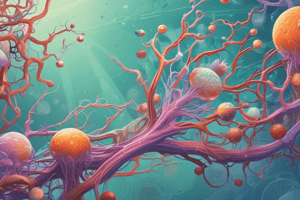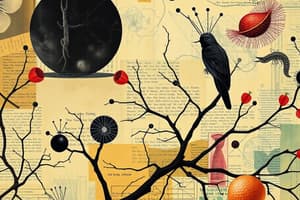Podcast
Questions and Answers
What is the hierarchical structure used to classify living organisms, and what are its main levels?
What is the hierarchical structure used to classify living organisms, and what are its main levels?
The hierarchical structure used to classify living organisms is called the taxonomic hierarchy. Its main levels are domain, kingdom, phylum, class, order, family, genus, and species, from broadest to most specific.
Explain the difference between anabolism and catabolism, and provide an example of each.
Explain the difference between anabolism and catabolism, and provide an example of each.
Anabolism is the process of building complex molecules from simpler ones, requiring energy input. An example is protein synthesis, where amino acids are joined to form proteins. Catabolism is the process of breaking down complex molecules into simpler ones, releasing energy. An example is cellular respiration, where glucose is broken down to release energy.
Why is photosynthesis crucial for life on Earth? What are its main products?
Why is photosynthesis crucial for life on Earth? What are its main products?
Photosynthesis is crucial for life on Earth because it converts light energy into chemical energy, which is the basis of most food chains. Its main products are glucose (a simple sugar), which provides energy for organisms, and oxygen, which is essential for cellular respiration.
Describe the roles of lipids in living organisms, and provide two examples of their importance.
Describe the roles of lipids in living organisms, and provide two examples of their importance.
What is the primary difference between prokaryotic and eukaryotic cells?
What is the primary difference between prokaryotic and eukaryotic cells?
Explain how biological principles and theories are interconnected and how they can impact daily life.
Explain how biological principles and theories are interconnected and how they can impact daily life.
Explain the concept of homeostasis and its significance in living organisms.
Explain the concept of homeostasis and its significance in living organisms.
What is the central idea behind the theory of evolution by natural selection?
What is the central idea behind the theory of evolution by natural selection?
How does the genetic code influence protein synthesis?
How does the genetic code influence protein synthesis?
What is the role of energy flow in an ecosystem?
What is the role of energy flow in an ecosystem?
Briefly describe the field of evolutionary biology and its importance in understanding life.
Briefly describe the field of evolutionary biology and its importance in understanding life.
Explain the relationship between genetics and heredity.
Explain the relationship between genetics and heredity.
What is the significance of the cell theory in understanding life?
What is the significance of the cell theory in understanding life?
Flashcards
Classification of Living Organisms
Classification of Living Organisms
The hierarchical organization of living organisms from domains to species.
The Three Domains
The Three Domains
Bacteria, Archaea, and Eukarya are the broadest categories of life.
Metabolism
Metabolism
The sum of all chemical reactions in an organism, including anabolism and catabolism.
Photosynthesis
Photosynthesis
Signup and view all the flashcards
Nucleic Acids
Nucleic Acids
Signup and view all the flashcards
Biology
Biology
Signup and view all the flashcards
Cell Theory
Cell Theory
Signup and view all the flashcards
Prokaryotic Cells
Prokaryotic Cells
Signup and view all the flashcards
Eukaryotic Cells
Eukaryotic Cells
Signup and view all the flashcards
Evolution by Natural Selection
Evolution by Natural Selection
Signup and view all the flashcards
Homeostasis
Homeostasis
Signup and view all the flashcards
Genetic Code
Genetic Code
Signup and view all the flashcards
Study Notes
General Biology Concepts
- Biology is the scientific study of life and living organisms, encompassing their structure, function, growth, origin, evolution, and distribution.
- Key characteristics of life include: cellular organization, reproduction, metabolism, growth and development, response to stimuli, adaptation through evolution, and homeostasis.
- All living organisms are composed of cells, the basic unit of life.
- There are two main types of cells: prokaryotic (lacking a nucleus and membrane-bound organelles) and eukaryotic (possessing a nucleus and membrane-bound organelles).
Branches of Biology
- Botany: The study of plants, encompassing their structure, function, classification, evolution, and ecology.
- Zoology: The study of animals, including their behavior, physiology, classification, and ecology.
- Microbiology: The study of microorganisms, including bacteria, viruses, fungi, and protists.
- Genetics: The study of heredity and variation in organisms, focusing on genes, DNA, and inheritance patterns.
- Ecology: The study of the interactions between organisms and their environment, including populations, communities, ecosystems, and biomes.
- Physiology: The study of the functions of living organisms and their parts.
- Molecular Biology: The study of biological molecules, including proteins, DNA, and RNA, and their functions.
- Evolutionary Biology: The study of the processes that have led to the diversity of life on Earth.
- Biochemistry: The study of the chemical processes that occur within living organisms.
Core Biological Principles
- Cell Theory: All living organisms are composed of cells; cells are the basic unit of structure and function in living things; all cells come from pre-existing cells.
- Evolution by Natural Selection: Organisms change over time through the process of natural selection, driven by their ability to adapt to the environment, producing heritable traits.
- Homeostasis: The maintenance of a stable internal environment in an organism to ensure optimal function.
- Energy Flow: The flow of energy through ecosystems, generally starting with the sun, fueling life processes.
- Genetic Code: The specific sequence of nucleotides (DNA) that dictates the order of amino acids in proteins. Proteins make up much of the anatomy, regulate processes, and carry out virtually all cellular functions.
Classification of Living Organisms
- The classification of living organisms is hierarchical, organized from broad categories (domain) to increasingly specific ones (species).
- The three domains are Bacteria, Archaea, and Eukarya.
- Within each domain, organisms are further classified into kingdoms, phyla, classes, orders, families, genera, and species. Binomial nomenclature (a two-part naming system) is used to uniquely identify each species.
Biological Processes
- Metabolism: The sum of all chemical reactions occurring within a living organism. Includes anabolism (building complex molecules) and catabolism (breaking down complex molecules).
- Photosynthesis: The process by which plants and other organisms use light energy to convert carbon dioxide and water into carbohydrates and oxygen.
- Cellular Respiration: The process of breaking down carbohydrates to release energy for cellular functions.
- Reproduction: The process by which organisms produce offspring, enabling the continuation of the species.
Key Biological Molecules
- Carbohydrates: Provide energy and structural support.
- Lipids: Store energy, form cellular membranes, and function in hormone production.
- Proteins: Essential for structural support, catalysis (enzymes), transport, and many other vital cellular functions.
- Nucleic Acids: (DNA and RNA) Store and transmit genetic information crucial for the development and function of cells.
Interconnectedness within Biology
- All biological systems are interconnected. Changes in one part of an ecosystem or organism will inevitably affect other parts.
- Evolution and environmental pressures significantly shape organisms and populations.
- Biological principles, theories, and applications extend across different fields, impacting many aspects of daily life.
Studying That Suits You
Use AI to generate personalized quizzes and flashcards to suit your learning preferences.




